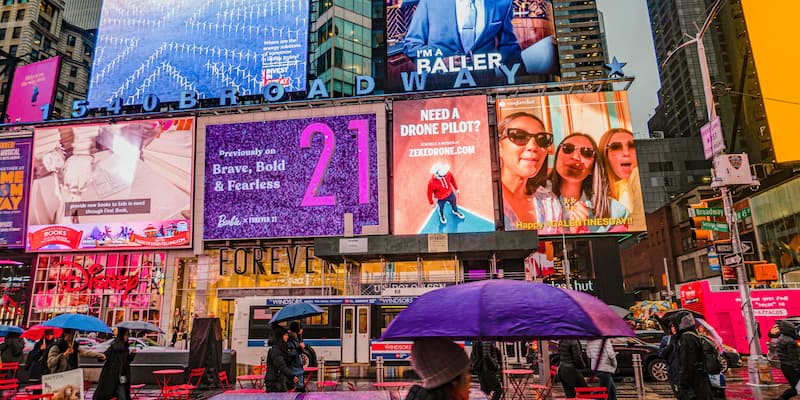We’re hearing more and more about out-of-home advertising these days. That’s not a surprise, considering that the post-pandemic re-emergence into the real world is well underway. People are determined to enjoy life to the fullest again. For many, that means not only getting out of the house but getting away from their digital screens.
Out-of-home (OOH) advertising feels fresh and new, even though it has been around for decades. And when you learn that 99% of marketers believe OOH is the “perfect counter-balance” to digital fatigue, it’s easy to understand why there’s so much buzz.
So, what is OOH?
If you answered “billboards,” you’re right. However, you are also oh, so wrong. Billboards are just the proverbial tip of the iceberg—the most obvious and well-known out-of-home platform. If you’re new to the world of OOH, the Outdoor Advertising Association of America (OAAA) offers a comprehensive list that describes dozens of OOH inventory types.
These inventory options can be broadly divided into two categories:
Out-of-Home Advertising: Traditional Outdoor Media
- Static billboards—Not just the traditional roadside version, but smaller bulletins and posters as well as wild postings, painted murals, and wall projections
- Mobile billboards—LED trucks and wrapped vehicles which can transport ads around town or serve as pop-up sampling stations or gathering points
- Street furniture—Bus shelters, benches, phone and information kiosks, banners, and urban panels
- Public transit (both interior and exterior advertising)—Buses, subways and rail trains, taxis, and rideshares
With all that, it’s important to note that the term “outdoor” advertising has been replaced by “out-of-home” because modern OOH also offers a wealth of indoor opportunities to reach audiences. This is especially true now that the industry has seen explosive growth in digital screen placements and programmable indoor display networks.
Out-of-Home Advertising:
Place-Based Media
Anywhere people visit for work, shopping, or leisure that has walls or floor space or digital screens is a potential venue for OOH advertising:
- Airports—Posters, digital screens, wall dioramas, kiosks
- Airplanes—Seatback screens and in-flight movies
- Indoor screens—Retail stores, groceries, health clubs, waiting rooms and lobbies, restaurants, bars, etc.
- Gas and EV stations
- Shopping malls
- Stadiums and arenas
- Conference centers and special events
How can you use all of these advertising options to energize audiences jaded by overexposure to online advertising?
Out-of-Home Advertising Goes Everywhere
Out-of-home is generally considered a single advertising channel, but it is a broad range of opportunities marketers can pull together as needed depending on campaign goals and audiences. As such, OOH is the only channel that gives you complete coverage.
Content can be static or dynamic, stationary or mobile. Ads can be massive or as small as a smartphone screen. Though most OOH is land-based, ads can also be displayed in the air (blimps, balloons, skywriters, and banners) or on the water (boats and barges).
OOH allows targeting with geographic as well as demographic criteria, making it easy to place your message in the right places at the right times. Combining location targeting with contextual content further increases relevance and impact.
AI can help refine location and audience targeting, so you can reach your audience where they already are. OOH is only effective when the audience is interested in the ad. Therefore, accurate targeting is a necessity in the planning and buying process.
Out-of-Home Advertising Turns Ads Into an Activity
Sometimes all you need is a simple message—content that reinforces your brand. However, sales-minded marketers know that conversions require audience engagement. In the same survey where marketers called OOH the perfect antidote to digital fatigue, 84% of them said interactive features are the future of OOH advertising.
Look for more QR codes, interactive displays, augmented reality, and recognition-enabled displays in the future.
Out-of-Home Advertising Plays Well with Others
While out-of-home has the power to counteract digital weariness, it can also be the perfect companion to digital advertising. Traditional OOH is always “on,” with 100% viewability around the clock, without clutter or interruption. Including these ads in a multi-channel campaign can increase search advertising ROI by 40%.
Simply adding billboards to a Facebook campaign can dramatically increase your ad’s reach and frequency and deliver an exponential lift in results.
According to the OAAA, consumers may be tuned out online, but they are tuning in like never before once they leave home. They are noticing their outdoor surroundings more than pre-pandemic, and they’re noticing OOH advertising more, too. Even better for marketers, OOH inspires action—92% of millennials are “extremely likely” to buy after seeing OOH ads.
When 99 out of 100 marketers say they’re looking to OOH to reconnect with consumers out in the real world, it pays to learn more about modern out-of-home and how your brand can stand out with traditional and AI-powered OOH.
Jeanne Hopkins
Chief Revenue Officer at OneScreen.ai, an AI-powered out-of-home (OOH) advertising solution.



